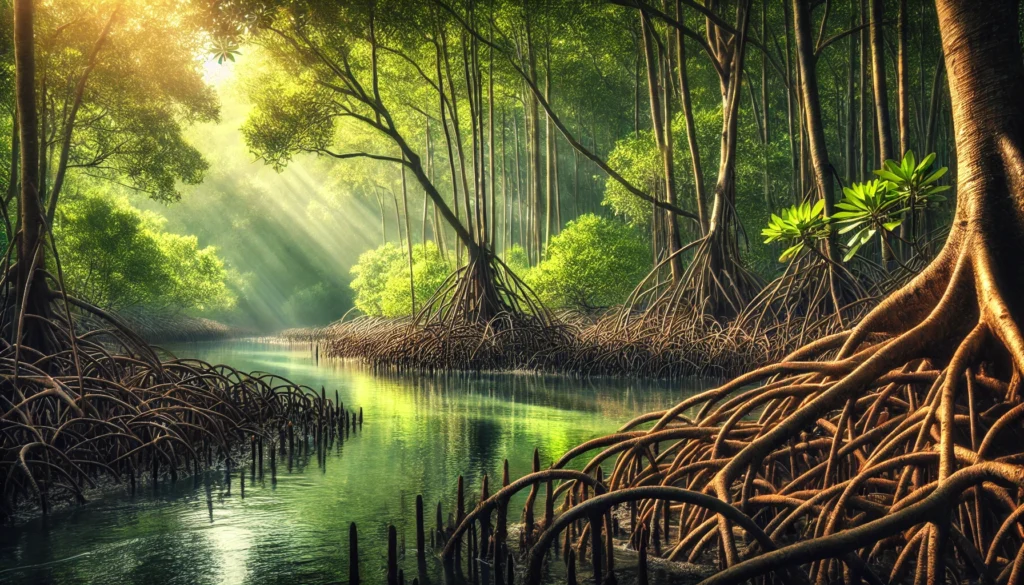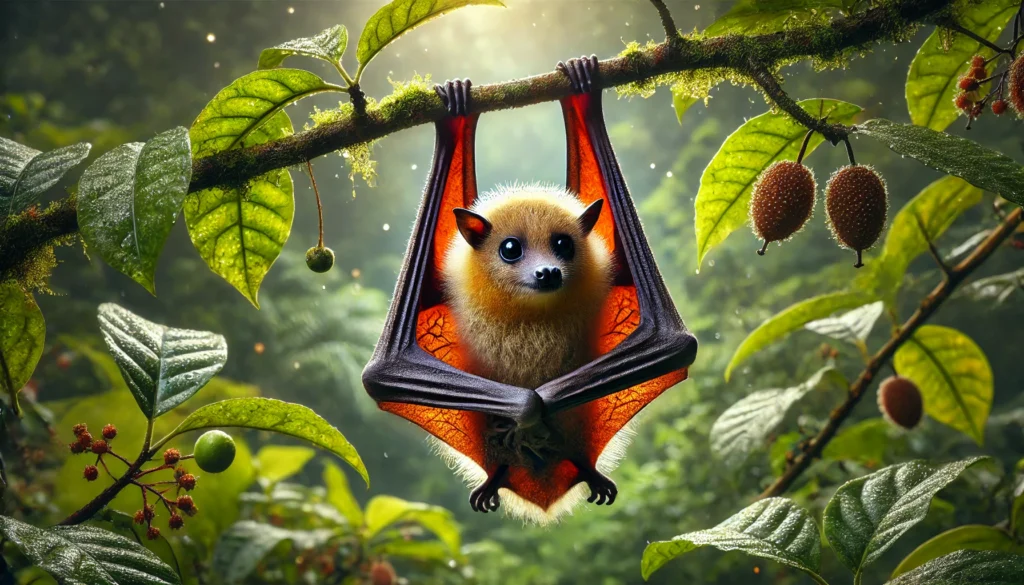Hey there, nature enthusiasts and curious coastline dwellers! Today, we’re diving into the wonderful world of mangrove forests. Now, I know what you’re thinking: “Mangroves? Aren’t those just those weird trees that grow in the mud?” Well, buckle up, buttercup, because you’re about to discover why these peculiar plants are the unsung heroes of our shorelines.
What Are Mangrove Forests, Anyway?
Let’s start with the basics, shall we? Mangrove forests are like the superhero team of the plant world. These extraordinary ecosystems thrive in the challenging interface between land and sea, where most plants would throw in the towel and call it quits. But not mangroves – oh no, they’ve got tricks up their sleeves (or should I say, up their roots?).
The Salt-Tolerant Superheroes
Imagine trying to live in a place where you’re constantly bombarded with saltwater. Sounds like a recipe for disaster, right? Well, mangroves have evolved to be the ultimate salt-tolerant superheroes. They’ve developed specialized mechanisms to deal with high salinity levels that would make other plants wilt faster than a delicate flower in a desert. Some mangrove species have salt-filtering roots, while others can excrete excess salt through their leaves. It’s like they have their own built-in desalination plants!
The Muddy Marvels
Now, let’s talk about that mud. Mangroves don’t just tolerate it; they thrive in it. These muddy marvels have adapted to life in waterlogged soils that would suffocate most other plants. They’ve developed unique root systems that allow them to breathe even when partially submerged. Some mangrove species have aerial roots that stick up out of the mud like snorkels, while others have prop roots that arch out from the trunk, creating a tangled web of support. It’s like they’re playing an eternal game of “The Floor is Lava,” except in this case, it’s “The Floor is Mud.”
The Global Mangrove Club: Where in the World Are They?
Mangrove forests aren’t just hanging out in one exclusive location. Oh no, they’ve formed a global club, spanning tropical and subtropical coastlines around the world. Let’s take a whirlwind tour of the prime mangrove real estate, shall we?
Mangrove Hotspots
| Region | Percentage of Global Mangrove Coverage |
|---|---|
| South and Southeast Asia | 42% |
| The Americas | 27% |
| West and Central Africa | 15% |
| Australia and New Zealand | 7% |
| East Africa and the Middle East | 9% |
As you can see, South and Southeast Asia are winning the mangrove popularity contest, boasting a whopping 42% of the world’s mangrove forests. Countries like Indonesia, Malaysia, and Bangladesh are like the cool kids in the mangrove high school. The Americas come in second, with Brazil and Mexico leading the charge. Africa’s not far behind, while Australia and New Zealand are holding their own down under.
The Mangrove Melting Pot
Now, you might be thinking, “Aren’t all mangroves the same?” Oh, you sweet summer child. The world of mangroves is a veritable melting pot of diversity. There are over 70 species of mangroves, each with its own quirks and characteristics. From the towering Rhizophora trees with their iconic prop roots to the more modest Avicennia with their pencil-like pneumatophores, mangrove forests are a botanical buffet of variety.
Why Mangrove Forests Are the MVPs of Coastal Ecosystems
Alright, now that we’ve covered the basics, let’s dive into why mangrove forests deserve a standing ovation (or at least a round of applause from the local crabs). These coastal guardians are working overtime to keep our shorelines safe and sound.
Nature’s Storm Barriers
Picture this: a category 5 hurricane is barreling towards the coast. Most folks are boarding up windows and heading for the hills. But mangroves? They’re standing tall, ready to take on Mother Nature’s fury. These tough trees act as natural storm barriers, absorbing the impact of waves and reducing wind speeds. It’s like they’re saying, “Bring it on, storm! We eat cyclones for breakfast!”
In fact, studies have shown that mangrove forests can reduce wave height by up to 66% over 100 meters of forest. That’s some serious wave-busting power! And it’s not just about protecting the coastline – mangroves also help prevent erosion, keeping our beaches where they belong instead of floating off to join some distant sandbar.
Carbon Sequestration Superstars
Hold onto your hats, because here’s where things get really impressive. Mangrove forests are absolute rock stars when it comes to carbon sequestration. These coastal ecosystems can store up to four times more carbon than tropical rainforests. Yes, you read that right – four times more!
Let’s break it down:
| Ecosystem | Carbon Storage Capacity (tons per hectare) |
|---|---|
| Mangrove Forests | 1,000 – 3,000 |
| Tropical Rainforests | 200 – 400 |
Mangroves are like nature’s carbon vacuum cleaners, sucking up CO2 and storing it in their biomass and the muddy soil beneath them. It’s their way of saying, “Global warming? Not on our watch!”
Biodiversity Bonanza
If mangrove forests were throwing a party, it would be the most diverse shindig in town. These ecosystems are teeming with life, both above and below the waterline. From colorful fish and crustaceans to birds and mammals, mangroves provide a home for an incredible array of species.
Let’s take a peek at some of the party guests:
- Fish: Mangroves serve as nurseries for many fish species, including commercial favorites like snapper and grouper. It’s like a fishy daycare center!
- Birds: Herons, kingfishers, and even flamingos call mangrove forests home. It’s a birdwatcher’s paradise!
- Mammals: From monkeys swinging through the canopy to manatees grazing on mangrove leaves, these forests are a mammalian playground.
- Reptiles: Crocodiles, snakes, and sea turtles all find refuge in mangrove ecosystems. It’s like a reptile resort!
The Human Connection: How Mangroves Keep Us Afloat
Now, you might be thinking, “That’s all well and good for the animals, but what about us humans?” Well, hold onto your eco-friendly hats, because mangroves have got our backs too!
The Fishing Industry’s Best Friend
Remember those fish nurseries we mentioned earlier? Well, they’re not just good for the fish – they’re great for our wallets too! Mangrove forests support both commercial and subsistence fishing industries around the world. It’s estimated that over 80% of global fish catches are directly or indirectly dependent on mangroves. That’s a whole lot of fish and chips!
Ecotourism Extravaganza
Move over, tropical beaches – mangrove forests are the new hotspot for eco-conscious travelers. From kayaking through twisted root systems to birdwatching bonanzas, mangrove tourism is on the rise. It’s like a natural theme park, minus the overpriced snacks and long queues (though you might have to wait your turn to spot that elusive kingfisher).
Traditional Medicine Cabinet
Mangroves aren’t just pretty faces – they’ve got healing powers too! Many coastal communities have long used various parts of mangrove plants for traditional medicines. From treating skin diseases to alleviating pain, these plants are like nature’s pharmacy. Just don’t try self-medicating without expert guidance – we don’t want any mangrove-induced mishaps!
The Dark Side: Threats to Mangrove Forests
Alright, folks, it’s time to put on our serious hats for a moment. As amazing as mangrove forests are, they’re facing some serious threats. It’s like they’re the protagonists in a suspense thriller, and the villains are closing in.
Deforestation Dilemma
Here’s a sobering statistic for you: between 1980 and 2005, the world lost approximately 35% of its mangrove forests. That’s more than one-third of these crucial ecosystems gone in just 25 years! The culprits? Urbanization, agriculture, and aquaculture are the main offenders.
| Period | Global Mangrove Loss |
|---|---|
| 1980-2005 | 35% |
| 2000-2016 | 2% |
The good news is that the rate of mangrove loss has slowed in recent years, thanks to increased awareness and conservation efforts. But we’re not out of the woods (or the mangroves) yet!
Climate Change Challenges
As if deforestation wasn’t enough, mangroves are also facing the looming threat of climate change. Rising sea levels, changes in precipitation patterns, and increased storm intensity all pose risks to these coastal guardians. It’s like they’re playing an environmental version of “The Floor is Lava,” except the lava keeps rising!
Pollution Problems
Last but not least, we’ve got pollution. From oil spills to plastic waste, human-generated pollutants are wreaking havoc on mangrove ecosystems. It’s like we’re throwing a giant, toxic party in their backyard and forgetting to clean up afterward.
Hope on the Horizon: Conservation and Restoration Efforts
But fear not, dear readers! All is not lost in the world of mangroves. Around the globe, scientists, conservationists, and local communities are rolling up their sleeves and getting their hands muddy (literally) to protect and restore these vital ecosystems.
Restoration Rock Stars
Mangrove restoration projects are popping up faster than you can say “pneumatophore” (that’s a type of mangrove root, in case you were wondering). From community-led initiatives to large-scale government programs, people are working hard to bring mangroves back from the brink.
One shining example is the Mangrove Action Project, which has been championing mangrove conservation and restoration since 1992. They’ve been spreading the mangrove love across countries like Thailand, Indonesia, and Honduras, using innovative techniques like Community-Based Ecological Mangrove Restoration (CBEMR).
Policy Power Moves
Governments around the world are starting to wake up to the importance of mangroves. Many countries have implemented policies to protect these coastal ecosystems and regulate activities that threaten them. For instance, Indonesia has pledged to restore 600,000 hectares of mangrove forests by 2024. That’s like replanting an area larger than Delaware with mangroves!
Education and Awareness
Last but not least, there’s a growing movement to educate people about the importance of mangroves. From school programs to community workshops, people are learning about these coastal superheroes and how to protect them. It’s like a global mangrove fan club, and everyone’s invited!
Wrapping It Up: The Mangrove Manifesto
As we come to the end of our mangrove adventure, let’s take a moment to reflect on what we’ve learned. Mangrove forests are more than just muddy, mosquito-infested swamps (although, let’s be honest, they can be that too). They’re coastal guardians, carbon-sequestering superstars, and biodiversity hotspots all rolled into one.
From protecting our shorelines against storms to supporting global fisheries, mangroves are working overtime to keep our planet healthy and our coastal communities thriving. They’re the unsung heroes of the natural world, quietly doing their job without asking for recognition or rewards (although I’m sure they wouldn’t mind if we stopped cutting them down).
So, the next time you’re near a coastline, take a moment to appreciate these muddy marvels. And if you’re feeling inspired, why not get involved in local conservation efforts? After all, every little bit helps when it comes to protecting our mangrove forests.
Remember, folks: in the game of coastal protection, mangroves are the real MVPs. Let’s give them the standing ovation they deserve!
Disclaimer: This blog post is based on information available up to 2020. While we strive for accuracy, the world of mangrove research is constantly evolving. If you spot any inaccuracies, please let us know so we can update our information faster than a mangrove can filter saltwater!




